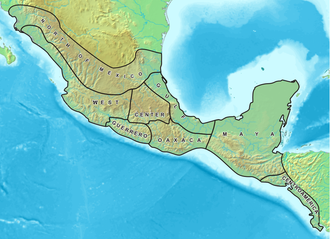 Global Information
Global InformationMesoamerica information
This article needs additional citations for verification. (October 2022) |

Mesoamerica is a historical region and cultural area that begins in the southern part of North America and extends to the Pacific coast of Central America, thus comprising the lands of central and southern Mexico, all of Belize, Guatemala, El Salvador, and small parts of Honduras, Nicaragua and Costa Rica.[1][2][3] [4]As a cultural area, Mesoamerica is defined by a mosaic of cultural traits developed and shared by its indigenous cultures.[5][2][6][7]
In the pre-Columbian era, many indigenous societies flourished in Mesoamerica for more than 3,000 years before the Spanish colonization of the Americas began on Hispaniola in 1493. In world history, Mesoamerica was the site of two historical transformations: (i) primary urban generation, and (ii) the formation of New World cultures from the mixtures of the indigenous Mesoamerican peoples with the European, African, and Asian peoples who were introduced by the Spanish colonization of the Americas.[8] Mesoamerica is one of the six areas in the world where ancient civilization arose independently (see cradle of civilization), and the second in the Americas, alongside the Caral–Supe in present-day Peru. Mesoamerica is also one of only five regions of the world where writing is known to have independently developed (the others being ancient Egypt, India, Sumer, and China).[9]
Beginning as early as 7000 BCE, the domestication of cacao, maize, beans, tomato, avocado, vanilla, squash and chili, as well as the turkey and dog, resulted in a transition from paleo-Indian hunter-gatherer tribal groupings to the organization of sedentary agricultural villages. In the subsequent Formative period, agriculture and cultural traits such as a complex mythological and religious tradition, a vigesimal numeric system, a complex calendric system, a tradition of ball playing, and a distinct architectural style, were diffused through the area. Villages began to become socially stratified and develop into chiefdoms, and large ceremonial centers were built, interconnected by a network of trade routes for the exchange of luxury goods, such as obsidian, jade, cacao, cinnabar, Spondylus shells, hematite, and ceramics. While Mesoamerican civilization knew of the wheel and basic metallurgy, neither of these became technologically relevant.[10]
Among the earliest complex civilizations was the Olmec culture, which inhabited the Gulf Coast of Mexico and extended inland and southwards across the Isthmus of Tehuantepec. Frequent contact and cultural interchange between the early Olmec and other cultures in Chiapas, Oaxaca, and Guatemala laid the basis for the Mesoamerican cultural area. All this was facilitated by considerable regional communications in ancient Mesoamerica, especially along the Pacific coast.
In the subsequent Preclassic period, complex urban polities began to develop among the Maya,[11][12] with the rise of centers such as Aguada fénix and Calakmul in Mexico; El Mirador, and Tikal in Guatemala, and the Zapotec at Monte Albán. During this period, the first true Mesoamerican writing systems were developed in the Epi-Olmec and the Zapotec cultures. The Mesoamerican writing tradition reached its height in the Classic Maya logosyllabic script.
In Central Mexico, the city of Teotihuacan ascended at the height of the Classic period; it formed a military and commercial empire whose political influence stretched south into the Maya area and northward. Upon the collapse of Teotihuacán around 600 AD, competition between several important political centers in central Mexico, such as Xochicalco and Cholula, ensued. At this time during the Epi-Classic period, the Nahua peoples began moving south into Mesoamerica from the North, and became politically and culturally dominant in central Mexico, as they displaced speakers of Oto-Manguean languages.
During the early post-Classic period, Central Mexico was dominated by the Toltec culture, and Oaxaca by the Mixtec. The lowland Maya area had important centers at Chichén Itzá and Mayapán. Towards the end of the post-Classic period, the Aztecs of Central Mexico built a tributary empire covering most of central Mesoamerica.[13]
The distinct Mesoamerican cultural tradition ended with the Spanish conquest in the 16th century. Eurasian diseases such as smallpox and measles, which were endemic among the colonists but new to North America, caused the deaths of upwards of 90% of the indigenous people, resulting in great losses to their societies and cultures.[14][15] Over the next centuries, Mesoamerican indigenous cultures were gradually subjected to Spanish colonial rule. Aspects of the Mesoamerican cultural heritage still survive among the indigenous peoples who inhabit Mesoamerica. Many continue to speak their ancestral languages and maintain many practices hearkening back to their Mesoamerican roots.[16]
- ^ "Mesoamerica". Education | National Geographic Society. Archived from the original on Dec 30, 2023.
- ^ a b Wyatt, Andrew R.; Monaghan, John (2010-12-13). "Mesoamerica". In Holloway, Thomas H. (ed.). A Companion to Latin American History. John Wiley & Sons. pp. 24–41. ISBN 978-1-4443-3884-3.
- ^ Kilroy-Ewbank, Lauren. "Mesoamerica, an introduction". Art of the Americas to World War I. Khan Academy. Archived from the original on Nov 7, 2023.
- ^ "The Archaeology of Mesoamerica", Latin American Studies, Oxford University Press, 2022-02-21, doi:10.1093/obo/9780199766581-0263, ISBN 978-0-19-976658-1, retrieved 2024-04-14
- ^ Kilroy-Ewbank, Lauren (September 12, 2017). "Mesoamerica, an introduction". Smarthistory. Retrieved 2023-04-16.
- ^ "The Archaeology of Mesoamerica", Latin American Studies, Oxford University Press, 2022-02-21, doi:10.1093/obo/9780199766581-0263, ISBN 978-0-19-976658-1, retrieved 2024-04-14
- ^ Woodfill, Brent (2018-10-25), "Mesoamerican Archaeology", Anthropology, Oxford University Press, doi:10.1093/obo/9780199766567-0194, ISBN 978-0-19-976656-7, retrieved 2024-04-14
- ^ Carrasco 2001.
- ^ Fagan 1996, p. 762.
- ^ Carmack, Gasco & Gossen 1996, p. 55.
- ^ "Exploring the Maya World". Google Arts & Culture. Archived from the original on Jan 25, 2024.
- ^ "Who Are the Maya?". Google Arts & Culture.
- ^ Carmack, Gasco & Gossen 1996, pp. 40–80.
- ^ "Meso-America", Oxford English Reference Dictionary, 2nd ed. (rev.) 2002. (ISBN 0-19-860652-4) Oxford: Oxford University Press; p. 906.
- ^ (2000): Atlas del México Prehispánico. Revista Arqueología mexicana. Número especial 5. Julio de 2000. Raíces/ Instituto Nacional de Antropología e Historia. México.
- ^ Carmack, Gasco & Gossen 1996, p. [page needed].